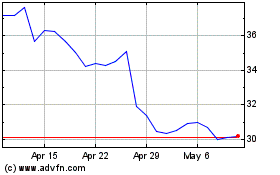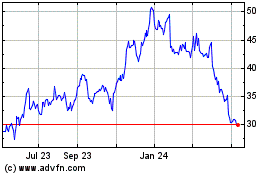By Theo Francis and Richard Rubin
This article is being republished as part of our daily
reproduction of WSJ.com articles that also appeared in the U.S.
print edition of The Wall Street Journal (May 4, 2018).
The largest U.S. companies found a new formula for success in
the first quarter: larger pretax profits and smaller tax bills --
mostly compliments of the federal tax overhaul.
More than half of the combined net-income growth reported by 200
large public companies for the first quarter stemmed from a decline
in the companies' effective tax rates, a Wall Street Journal
analysis of quarterly financial data from Calcbench found.
At a third of the companies, tax expenses fell in dollar terms
even as pretax income rose, boosted by strong revenue growth and
the expanding economy.
Chip giant Intel Corp.'s pretax profits rose $1.2 billion over
first quarter 2017 -- but tax expenses fell by $294 million.
Defense contractor Lockheed Martin Corp. said pretax profits rose
$325 million in the March quarter while tax costs fell $43
million.
The tax savings are helping to drive profits to new highs among
companies in the S&P 500 index. Overall, first-quarter
after-tax earnings for index companies were on track through
Wednesday to rise 25.3% over the 2017 period, according to Thomson
Reuters. That would mark the seventh straight quarter of per-share
profit growth and the strongest gains in more than seven years.
A cut in the U.S. corporate tax rate to 21% from 35% was the
centerpiece of the federal overhaul passed in December, and
lawmakers and tax analysts expected the largest immediate benefits
would go to companies with few foreign operations and few tax
breaks to lose, such as retailers.
Confirming expectations that companies would benefit rapidly:
Pretax earnings for the S&P 500 are forecast to rise about half
as fast as after-tax earnings, at 12.1%, Thomson Reuters said.
"It's clearly not just the economy" driving corporate profits,
said Joseph LaVorgna, chief economist for the Americas at Natixis,
a corporate and investment bank. "Change in tax policy is part of
it."
Investors had anticipated big tax savings and pushed major U.S.
stock indexes to record highs earlier this year. In recent weeks,
gains have been more muted even as companies from Goldman Sachs
Group Inc. to Apple Inc. have reported strong results.
S&P 500 revenues are expected to rise from a year earlier at
a rate roughly on par with the fourth quarter's 8.3% for the
fastest clip since late 2011 and the seventh straight quarter of
growth, Thomson Reuters data show. The figures reflect reported
results -- as adjusted by stock analysts -- for about two-thirds of
companies in the index, and analyst estimates for the rest.
Energy, technology and financial firms have led per-share
earnings growth with gains of 30% or more, followed by companies in
the materials and industrial sectors, both above 25%. Real estate
has lagged behind, at 2.7% per-share earnings growth, as have
consumer staples, at 13% growth.
Broader data suggest that the tax overhaul has had at best a
modest impact on the economy as a whole. Gross domestic product
expanded at 2.3% in the first quarter, a slower pace than at the
end of 2017, as household spending cooled. But business investment
was strong and the tax benefits are showing up in the quarterly
results of the biggest U.S. corporations.
At CSX Corp., tax expenses in the first quarter were roughly
flat, despite a 57% increase in pretax earnings, "illustrating the
favorable impacts of tax reform," the railroad's chief financial
officer, Frank Lonegro, said in a mid-April conference call with
analysts. The company expects taxes to total about 25% of pretax
income this year, down from 38% last year.
In addition to a reduced income-tax rate at home, multinational
companies will benefit because they generally can now bring current
and future foreign profits back for U.S. investment, dividends or
share buybacks without paying an additional U.S. tax.
Many companies did face a one-time tax on the foreign profits
they had accumulated over the years. In most cases, companies
accounted for that and other one-time tax effects in the previous
quarter, meaning that the current earnings season is the first
clear picture of how companies are faring on an ongoing basis.
Now large companies are deciding what to do with their tax
windfalls. Apple on Tuesday boosted its dividend and said it would
repurchase $100 billion of its own shares from investors, the
latest in a flood of companies returning cash to investors.
Apple's tax costs for the first three months of 2017 were $3.7
billion, including an assumption that the company would pay U.S.
taxes on some of its foreign income. This year, those costs
declined by $1.3 billion even as pretax income went up by $1.5
billion. That deep a cut may be temporary, because aA new foreign
minimum tax likely won't apply to Apple until after its next fiscal
year starts later in 2018.
Many companies are returning their tax savings to investors. The
amount spent on share buybacks in the first quarter rose by more
than 50% over the fourth quarter of 2017, and by two-thirds over
the first quarter of 2017, according to S&P Dow Jones Indices.
Companies have also set plans to invest in expansion and new
technology, and some paid one-time bonuses to employees.
For 28 S&P 500 companies, lower taxes were enough to account
for the difference between reporting earnings growth and an
earnings decline. Those included chemical maker Monsanto Co., asset
manager T. Rowe Price Group Inc. and laboratory chain Quest
Diagnostics Inc.
A T. Rowe Price spokesman said the firm also recorded an
increase to net revenue and near-record asset inflows. "The tax
savings are also helping us accelerate investments in our strategic
priorities and increase the return of capital to our stockholders,"
he said.
Monsanto noted that, while its lower effective tax rate was
primarily a result of the tax overhaul, it also reflected other,
unspecified tax effects. Quest didn't respond to a request to
comment.
"More than ever, it matters to look at more than just the bottom
line," said Jack Ciesielski, an accounting analyst and publisher of
Analyst's Accounting Observer. "The lower tax rate could be masking
deteriorating fundamentals."
Corrections & Amplifications More than half of the combined
net-income growth reported by 200 large public companies in the
first quarter stemmed from a decline in the companies' effective
tax rates. An earlier version of this article incorrectly stated
that more than half of the combined net income was from the tax
overhaul.
Write to Theo Francis at theo.francis@wsj.com and Richard Rubin
at richard.rubin@wsj.com
(END) Dow Jones Newswires
May 04, 2018 02:47 ET (06:47 GMT)
Copyright (c) 2018 Dow Jones & Company, Inc.
Intel (NASDAQ:INTC)
Historical Stock Chart
From Mar 2024 to Apr 2024

Intel (NASDAQ:INTC)
Historical Stock Chart
From Apr 2023 to Apr 2024
